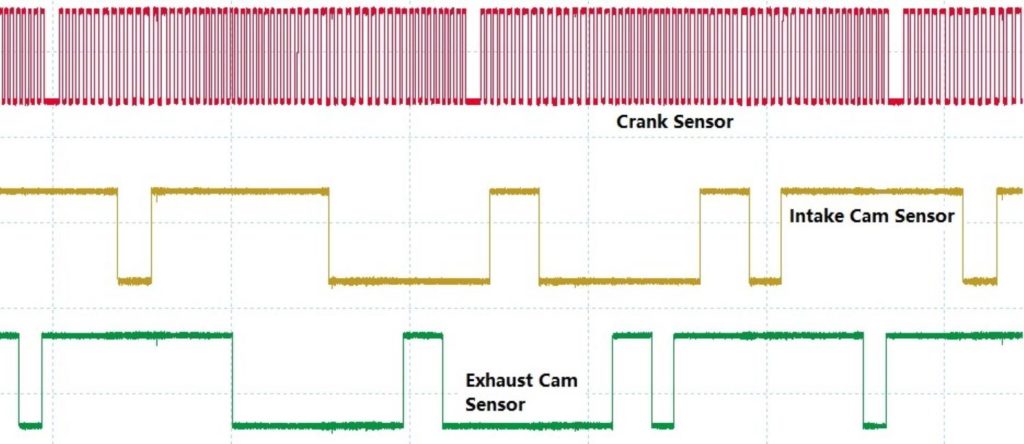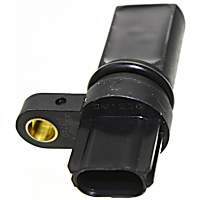What Does the P0341 Code Mean?
Diagnostic trouble code P0341 stands for “Camshaft Position Sensor “A” Circuit Range/Performance (Bank 1 or Single Sensor).” It is triggered when the powertrain control module (PCM) detects a problem with the signal being sent by the camshaft position sensor.
It’s important to note that this code won’t be set unless the cam sensor signal goes away.
P0341 code refers to a problem with the camshaft position sensor (CMP) signal on Bank 1. It could be that the signal coming from the CMP is not matching, not within the expected range, or not timed properly with the crankshaft position sensor’s (CKP) signal. You also have to take note that this code can be set by extended cranking periods.

To learn more about how the ECM/PCM uses signals from the CMP, you can read our in-depth explanation here.
Meanwhile, the “A” in the code refers to the intake camshaft in a straight overhead camshaft engine. Alternatively, if the engine employs a V configuration, the “A” typically refers to Bank 1’s intake camshaft.
Finally, the “bank 1” in the P0341 code refers to the side of the engine where the number one cylinder is located. Note that this only applies to engines with a boxer or V configuration.
P0341 on Some Honda Vehicles
CMP sensor A detects the intake camshaft timing and sends pulsing signals to the PCM. The PCM determines the advance or the retard of the camshaft timing according to the signals from the CKP sensor and CMP sensor A.
If the pulse deviates from a set range over a specified time period while the variable valve timing control (VTC) is not activated, the PCM detects a malfunction and stores a DTC.
Code P0341 may appear on some Honda vehicles. On a 2014 Honda CR-V LX 2.4L L4, for example, possible causes of the DTC P0341 can include:
- CMP sensor A poor installation
- Intake camshaft or cam chain poor installation
- CMP sensor A failure
- VTC actuator failure
What are the Possible Causes of the P0341 Code?
The code P0341 can be interpreted in different ways depending on the vehicle. Here are the most common causes of code P0341:
- Faulty CMP
- Circuit problems (e.g., damaged wiring and loose connections)
- Defective camshaft reluctor wheel
- Issues with timing components (e.g., a stretched timing chain or failed timing chain tensioner); NOTE: This will usually set other codes.
What are the Common Symptoms of the P0341 Code?
If you see a Check Engine (MIL) light and receive a P0341 code on your OBD-II scan tool, chances are you may experience one or more of these symptoms:
- No symptoms at all except the MIL (depending on the vehicle)
- Hard starting
- Intermittent starting (no start sometimes)
- Rolling idle and/or surging at low speeds
- Possible engine power loss (mild)
- Engine stalls when idling
- Engine idling too low or too high
- Engine misfires and runs rough
- Increased fuel consumption
- Engine spins normally but does not start
Some cam sensors are adjustable, (like those in distributors or cam synchronizers that go where the distributor used to go on earlier engines). There are special tools and procedures for cam sensor adjustment, so don’t try to guess at adjusting the cam sensor. Cam sensors that simply bolt into the valve cover or cam housing aren’t adjustable and are basically plug-and-play replacements. V engines usually have a cam sensor in each bank, and on some (like Nissans), one bad cam sensor can cause hard starting.
How to Diagnose the P0341 Code
Diagnosis is crucial in addressing the P0341 code. You need to determine the exact cause of the issue to determine the right way to resolve it, which can be tricky, especially if you are not an automotive professional.
If you are confident of your DIY car repair skill, you can investigate the trouble code to identify its root cause. Watch this helpful video reference to refresh your P0341 code know-how:
How to Fix the P0341 Code
Even though many OBD-II trouble codes share symptoms and causes, there is no universal way to resolve them. If you are not confident with your automotive know-how and DIY skills, do not attempt to resolve the P0341 code. Let an automotive expert handle the issue to avoid exacerbating it accidentally.
On the other hand, if you are certain you can resolve the P0341 code, determine the exact cause of the issue. Then, figure out the right solution using online auto repair resources and guides. You can also invest in an ALLDATA single-vehicle subscription, which will help you prepare for any other repairs that your vehicle may require in the future.
Finally, don’t forget to consult your owner’s manual before attempting to resolve the code P0341. Repair instructions may vary based on your vehicle’s make and model.
An In-Depth Look at the Camshaft Position Sensor
To complete a full four-stroke piston cycle (Down, Up, Down, Up), the crankshaft must complete two full 360 degree turns for a total of 720 degrees.
Starting with the first down stroke on a given piston, the intake valve is open (intake stroke) and the exhaust valve is closed. As the piston reaches the bottom of its travel, the intake valve is closed, and a fuel air mixture has been trapped so that the piston can compress this mixture on the following up stroke (compression stroke).

Just before the piston reaches the top, the ignition system sparks and triggers combustion so that when combustion pressure is at its peak, the piston has begun to travel down again (power stroke), and it’s this stroke that drives the crankshaft. The second up stroke is the exhaust stroke, where the exhaust valve opens and the byproduct of combustion is expelled.
Camshaft and Crankshaft Position Sensors
Okay, because the camshaft operates the valves in this order and the ECM/PCM always needs to know which cylinder is on its power stroke, the ECM/PCM uses crank sensor input (the crank sensor wheel usually has a tooth every 10 degrees and one missing tooth as a marker) along with cam sensor input to determine which cylinder is firing and when it fired.
One reason the cam sensor is necessary is to determine when to inject the fuel charge – on a conventional Multiport injection engine, the injectors follow the firing order of the engine, and so the ECM/PCM needs to know which injector to fire first. It uses crankshaft and camshaft position to make this determination.
One reason the cam sensor is necessary is to determine when to inject the fuel charge – on a conventional Multiport injection engine, the injectors follow the firing order of the engine, and so the ECM/PCM needs to know which injector to fire first. It uses crankshaft and camshaft position to make this determination.
–Richard McCuistian, ASE Certified Master Automobile Technician
Secondly the ECM/PCM needs to know when to inject the next fuel charge. All the combustion “fire” in the cylinder has burned out by the time the crankshaft has rotated 25 degrees or so after the spark plug ignites the mix – thus the injector waits until this crankshaft position has passed before the next injection event, even though the injected fuel is stored very briefly behind the closed intake valve. Think about it – an injection event with a leaking intake valve would cause induction backfire, which can be very destructive on vehicles with plastic intake manifolds.
Finally, in order to detect which cylinder is misfiring, the ECM/PCM, having stored a normal crankshaft speed pattern in its memory (color that “Crank Learn”), the ECM/PCM constantly compares real time crank/cam speed and position with its stored values just in case the crankshaft slows down during a cylinder firing event – if this happens more than a certain amount of times in a given interval (200 or 1000 rpm depending on misfire severity) on one cylinder, the ECM/PCM can store a code pointing to the misfiring cylinder based on camshaft sensor and crankshaft sensor information.
Camshaft Position Sensor Location
Some camshaft sensors are located in the distributor as Hall Effect or Optical units, but most cam sensors read directly from the camshaft itself, either using a Variable Reluctance Sensor (sine waveform) or a Hall Effect (square wave) sensor. Variable Reluctance (VRS) Sensors typically have one, two or three “teeth” on the camshaft or cam gear spinning past their tips. Hall Effect sensors will typically read slots cut in a cup shaped wheel that spins very near the sensor.
Professional mechanics use an oscilloscope to record camshaft and crankshaft waveforms together and compare those to known good waveforms to determine if an engine is out of time or if the Variable Valve Timing (VVT) system is functioning properly. A loss of the cam position sensor signal is an electrical rather than a mechanical concern. This is the scope capture of the cam and crank sensors on a 2010 Malibu 2.4L:


The ECM/PCM can monitor cam position using these signals – note the missing tooth on the crank sensor pattern – using that missing tooth and the cam sensor signals, the ECM/PCM can determine (and adjust) camshaft indexing. If one of the cam sensor signals flatlines or becomes “scratchy,” a code will be set.
Where to Get a New Camshaft Position Sensor for Your Vehicle
It’s important to replace a malfunctioning camshaft position sensor as soon as your mechanic recommends it. Thankfully, replacing a faulty camshaft position sensor is easy and hassle-free when you shop at CarParts.com. We carry an extensive selection of aftermarket parts from the top brands in the industry, so you can get your vehicle up and running in no time.
We value our customers and their online shopping experience, so we made sure that you can browse our website easily on any device. Sort and filter our catalog using our built-in vehicle selector to check out which parts are compatible with your vehicle’s specific year, make, and model.
We stand by the quality of the parts in our catalog, so we offer customers 60-day returns and a lifetime replacement guarantee. Shop now, and get the best deals today!
Products Mentioned in this Guide
Any information provided on this Website is for informational purposes only and is not intended to replace consultation with a professional mechanic. The accuracy and timeliness of the information may change from the time of publication.



 Camshaft Position Sensor
Camshaft Position Sensor
 Crankshaft Position Sensor
Crankshaft Position Sensor
 Camshaft
Camshaft
















